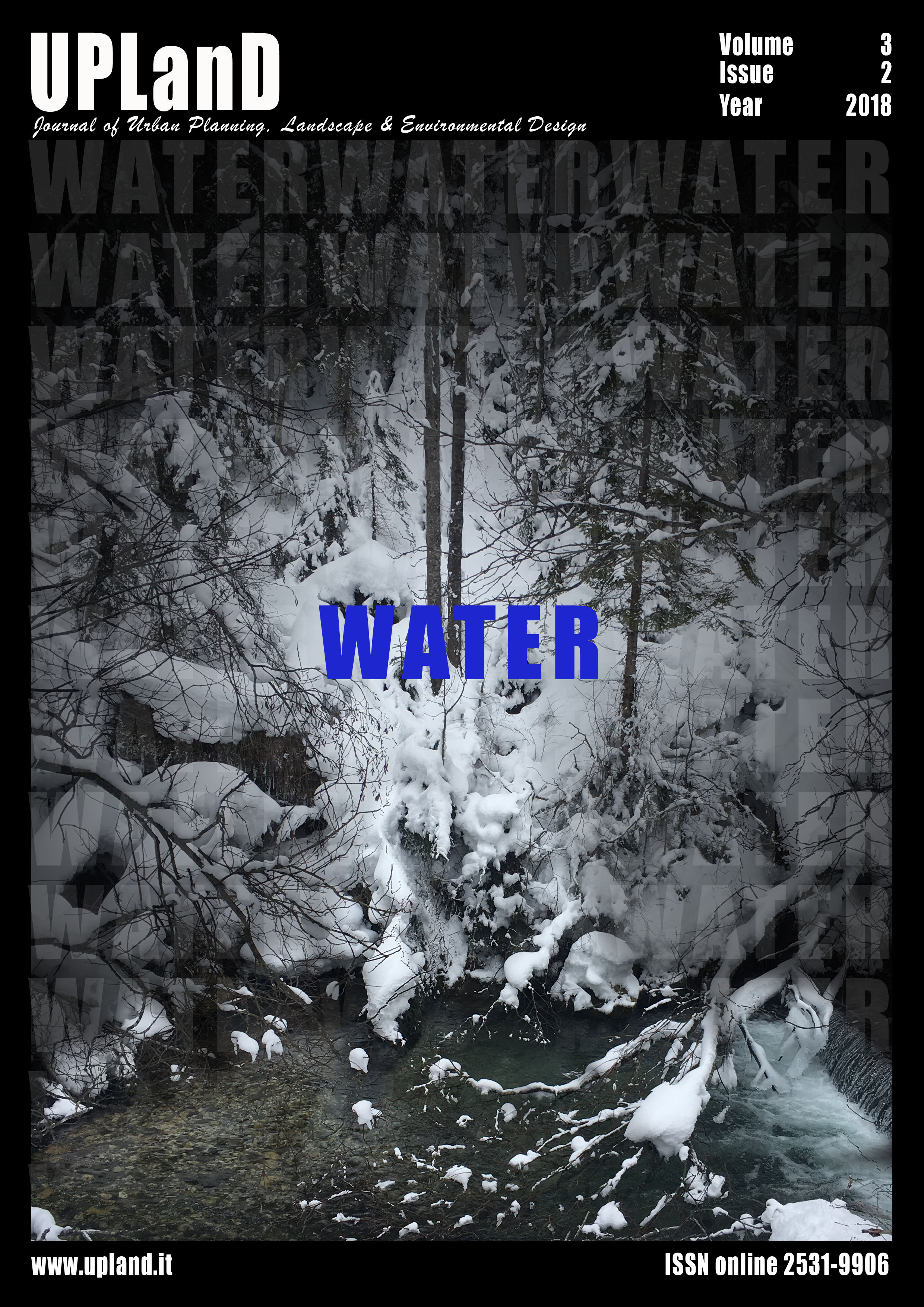The urban pressure on Italian river areas
Main Article Content
Abstract
Rivers have been the hub of economic and social development in the human evolution, because they are essential resources for: agricultural development, infrastructure networks and development of the first urban strategies. Territory has had a radical transformation that led to a national average urbanization of about 10%; but this development has happened with different degrees of awareness and without uniform models and criteria.
One of the main causes of this is due to an extreme fragmentation of planning, because the municipalities’ plans are a binding power modality, in force in Italy, but they don’t have significant and strategic references at regional and territorial scale. In particular, the Italian river areas have undergone a real siege by urban growth, outlining a critical scenario in terms of risks for the population and for the natural system.
Some disciplines such as landscape ecology have contributed substantially to the integration of some environmental issues that have led into greater consideration for the protection of the landscape. In the same way the concept of Ecosystem Services combines knowledge, techniques and legislation to achieve the goal of sustainable planning. So, it is necessary that these scientific disciplines, which deal with environmental planning in various ways, find the right devices to guarantee a multi-criteria approach to the problem of consumption of the Natural Capital.
Downloads
Article Details

This work is licensed under a Creative Commons Attribution-NonCommercial-NoDerivatives 4.0 International License.
Authors who publish with this journal agree to the following terms:- Authors retain copyright and grant the journal right of first publication with the work simultaneously licensed under a Creative Commons Attribution License that allows others to share the work with an acknowledgement of the work's authorship and initial publication in this journal.
- Authors are able to enter into separate, additional contractual arrangements for the non-exclusive distribution of the journal's published version of the work (e.g., post it to an institutional repository or publish it in a book), with an acknowledgement of its initial publication in this journal.
- Authors are permitted and encouraged to post their work online (e.g., in institutional repositories or on their website) prior to and during the submission process, as it can lead to productive exchanges, as well as earlier and greater citation of published work (See The Effect of Open Access).
References
Bravard, J.P., Amoros, C., & Pautou, G. (1986). Impact of civil engineering works on the successions of communities in a fluvial system, Oikos, 47, 92-111.
Oliva, F. (2010). Giuseppe Campos Venuti. Città senza cultura. Intervista sull’urbanistica. Bari, IT: Laterza.
Cassese, S. (2011). L’Italia: una società senza Stato?. Bologna, IT: Il Mulino Ed.
Ciabò, S., Fiorini, L., Zullo, F., Giuliani, C., Marucci, A., Olivieri, S., & Romano, B. (2017). L’emergenza post-sisma a L’Aquila, enfasi di una pianificazione debole. Archivio di studi urbani e regionali, 118, 73-96. doi: 0.3280/ASUR2017-118004
Chin, A. (2006). Urban transformation of river landscapes in a global context. Geomorphology, 79, 460–487.
Dematteis, G., & Emanuel, C. (1994). La diffusione urbana, interpretazioni e valutazioni. In G. Dematteis (ed.), Il fenomeno urbano in Italia: interpretazioni, prospettive, politiche (pp. 91-103). Milano, IT: Franco Angeli.
Downs, P.W., Gregory, K.J., & Brookes, A., (1991). How integrated is river basin management? Environmental Management, 15(3), 299–309.
European Community (EC), (2000). Directive 2000/60/EC of the European parliament and of the council of 23 October 2000 establishing a framework for community action in the field of water policy. Official Journal of the European Communities L327, pp. 1–72.
Fiorini, L., Zullo, F., Marucci, A., Ciabò, S., & Romano, B. (2016). I tessuti eco-urbani dello sprinkling: un recupero difficile. Proceedings of the Scientific Congress of SIEP-IALE. Asti, IT, Maggio 26-28, 2016.
Girel, J., Vautier, F., & Peiry, J. L. (2003). Biodiversity and land use history of the alpine riparian landscapes (the example of the Isère river valley, France). Multifunctional landscapes, 3, 167-200.
Hooke, J. M. (2006). Human impacts on fluvial systems in the Mediterranean region. Geomorphology, 79(3-4), 311-335.
ISPRA (2016). Consumo di suolo, dinamiche territoriale e servizi ecosistemici. Rapporto ISPRA 2016, Roma, IT.
ISPRA (2017). Consumo di suolo, dinamiche territoriale e servizi ecosistemici. Rapporto ISPRA 2017, Roma, IT.
Antrop, M. (2004). Landscape change and the urbanization process in Europe. Landscape and urban planning, 67(1-4), 9-26.
Marucci, A., Zullo, F., Morri, E., Fiorini, L., Santolini, R., & Romano, B. (2017). Spatial Methods to Measure Natura 2000 Sites Insularization in Italy. Proceedings of 17th International Conference on Computational Science and Its Applications (ICCSA 2017). Trieste, IT, Luglio 3-6, 2017.
Mioni, A. (1976). Le trasformazioni territoriali in Italia nella prima età industriale. Venezia, IT: Marsilio Ed.
Moss, T. (2004). The governance of land use in river basins: prospects for overcoming problems of institutional interplay with the EU Water Framework Directive. Land use policy, 21(1), 85-94.
Romano, B., Zullo, F., Fiorini, L., Marucci, A., & Ciabò, S. (2017). Land transformation of Italy due to half a century of urbanization. Land Use Policy, 67, 387-400.
Romano, B., Zullo, F., Fiorini, L., Ciabò, S., & Marucci, A. (2017). Sprinkling: An Approach to Describe Urbanization Dynamics in Italy. Sustainability, 9(1), 97.
Romano, B., Marucci, A., Zullo, F., Fiorini, L., & Ciabò, S. (2017). Urban pressure and planning management for Italian coastal areas. Proceedings of 6th International Symposium Monitoring of Mediterranean Coastal Areas. Problems and Measurement Techniques. Livorno, IT, Settembre 28-29, 2016.
Steele, M. K., & Heffernan, J. B. (2014). Morphological characteristics of urban water bodies: mechanisms of change and implications for ecosystem function. Ecological Applications, 24(5), 1070-1084.
Zullo, F., Marucci, A., Fiorini, L., Ciabò, S., & Romano, B. (2016). New techniques for land surveying, monitoring and environmental diagnosis: a comparative analysis. Proceedings of XIV International Forum World Heritage and Degradation, Smart Design, Planning and Technologies. Napoli, IT, Giugno 16-18, 2016.

